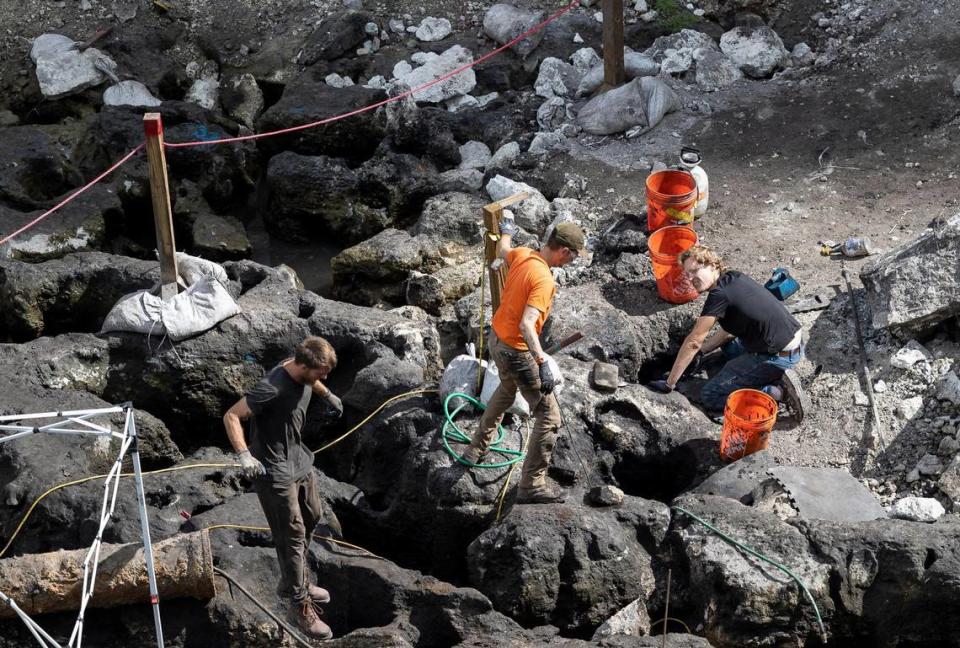What are next steps, what will be preserved at Brickell prehistoric site?

For months, as teams of archaeologists made find after startling find at the site of what’s turned out to be a major prehistoric indigenous site in the heart of Miami’s teeming Brickell district, the city’s historic preservation board took a decidedly hands-off approach to its oversight of the excavation.
On Tuesday, though, after weeks of mounting pressure from independent experts, activists and residents, the board — which is made up of volunteers appointed by elected officials — took action.
What did the board do? It used its considerable powers to compel the site’s influential owner, the Related Group, to do something the developer had not been eager to undertake: Publicly recognize and discuss the outsized significance of the ancient site, and legally commit to developing a plan, subject to board review and approval, to preserve, study and highlight discoveries believed to be thousands of years old.
What’s next? What shape that ultimately will take is still to be determined. And it will likely be months before the public gets a glimpse of what Related comes up with — and whether it’s enough to meet big expectations from the board, experts and residents.
What we know: What’s near certain is that Related will be able to carry out its plan to build as many as 1,400 residential units in three towers over the site, though it may have to preserve some portions or otherwise adapt its development blueprint to accommodate exhibitions and public access on the site.
Before Tuesday’s hearing, Related executives had consistently declined to address the findings publicly apart from a pair of general statements and required archaeological reports to the city preservation office.
But at a five-hour-long hearing before an overflow crowd at Miami City Hall, Related founder and Chairman Jorge Pérez and his attorneys said they’re already working on what they called a “preservation action plan” that should be ready for board review later this year.
And the respected archaeologist that’s been leading the excavation for Related, Robert Carr, made extensive public comments on the site’s importance as the capital of the Tequesta people dating back some 2,500 years — though he cast doubt on independent experts’ conclusions that indigenous use of the site may stretch back as long as 7,000 years.
“We are learning, in an extensive way, more than anything we’ve ever seen,” Carr said. “Miami, the town of Tequesta, was a major indigenous capital. This was a very complicated, stratified society.”
The board’s cudgel: The board members have power under city zoning ordinances to impose protections for properties that meet certain legal criteria as designated historic or archaeological landmarks. In February, the board asked city preservation staff to work with independent archaeologists on a proposal for designation of the Related property.
Related also got some of what it wanted.
In a concession to the developer, and under the implied threat of litigation, the board withdrew a proposal to designate as a protected landmark about half of the Related property, where plans for construction of a pair of residential towers are well underway. Those are the parcels where the extensive archaeological excavation, still ongoing in one large section, has taken place following demolition of a federal office building in 2021.
But the board voted 8-0 to start the process of designating the other half of the Related property at 444 Brickell Avenue, the site of an occupied office building that the developers plan to eventually replace with a third tower.
If the board approves historical designation, possibly around midyear, it would assume broad legal jurisdiction over preservation and development plans for that portion of the site, which experts think likely holds another rich trove of relics of prehistoric indigenous settlement. In theory at least, that means the board could withhold development permits until its members are satisfied with Related’s preservation plan.
Latest Related statement: In a statement issued Wednesday, Related’s president, Jon Paul Pérez — Jorge Pérez’s son — said his company agrees with the city’s approach.
“We are pleased with the Board’s decision allowing us to continue the archaeological excavation of the future home of the Baccarat Residences while developing an action plan to honor the site and secure the appropriate placement of the artifacts for future study,” he said in the statement.
“We also agree that the 444 Brickell site should be celebrated and honored. We will work with the city hand in hand on the designation of the 444 Brickell site. Our efforts will continue to be transparent and inclusive. We know that working together on the preservation of archaeologically significant sites is a collaborative effort that benefits everyone.”

